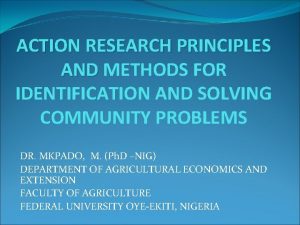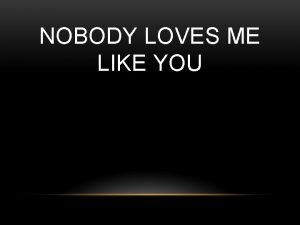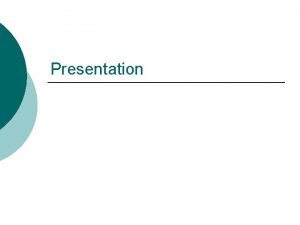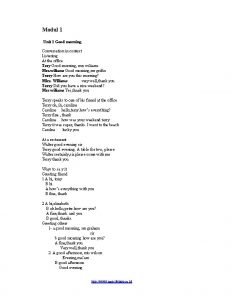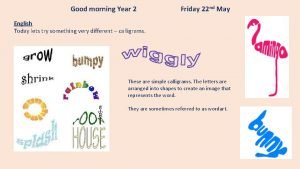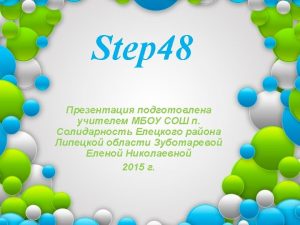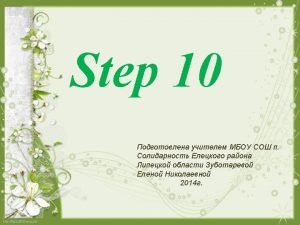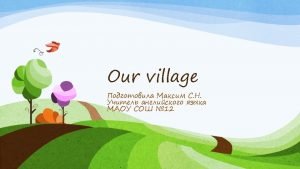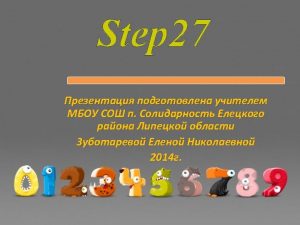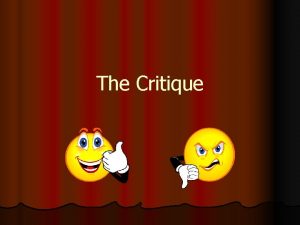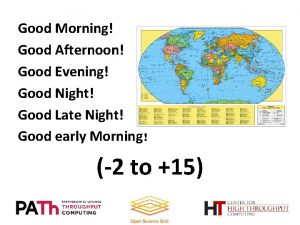Research critique Good morning Research critique It is










































- Slides: 42

Research critique Good morning

Research critique � It is a planned, careful, critical evaluation of a piece of research work against the prespecified criteria to judge the strength and weakness of the research study to improve overall quality of the research project.

Research Report �A Research Report is a document summarizing the main features of the study, including the problem statement, research methodology, the findings and interpretations.

CHARACTERISTICS OF A RESEARCH REPORT A well prepared report is � Complete, concise, clearly presented & logically organized. � Does not involve excessive jargon that is difficult for students and practicing nurses to read. � has a complete reference and presented in a consistent manner.

PURPOSES OF CRITIQUE To Cultivate critical thinking To induce the students to use newly acquired skills in research methods. • The evaluate its credibility to present in conference. • To evaluate its utility for EBNP • To assess its credibility to publish in journals (Publication decision)/ present in journal club � To identify areas of adequacy and inadequacy virtues as will as faults. • •

PURPOSES OF CRITIQUE � Critique is a useful task to apply the knowledge of research. � Identifying the strengths and weaknesses of the study including the constraints and limitations. � helps to review the research process. � The exercise gives a room for thoughtfulness and to hold the analysis in practical terms.

PURPOSES OF CRITIQUE � Acts as a guide to researchers, editors and practitioners. � Gives room for the authenticity of the information and analyzes the credibility of the findings � to weigh the evidence base in terms of practicality, objectivity, utilization, application and replication possibility.

CRITIQUE PROCESS 1. Comprehension: understanding the terms and concepts in the report, identifying the elements or steps of the research process such as problem, purpose, framework and design.

CRITIQUE PROCESS 2. Comparison: requires what each step of the research process should be like and then the ideal is compared to the real.

CRITIQUE PROCESS 3. Analysis: Involves critique of the logical links connecting one study element with another. 4. Evaluation: The evaluation becomes a summary of the study’s quality that builds on conclusion

Guidelines for the conduct of written Research critique 1. 2. 3. 4. 5. 6. Read & understand research report carefully Avoid general vague statements Be sure to comment on the study’s strengths as well as limitations. (balanced approach) Give specific examples of the study’s strengths and limitation. Avoid exaggerated praise and fault finding. Try to justify your criticism offer a rationale for how a different method / approach would have solved the problem.

Conti…. Be as objective as possible. Avoid bias (some time you may find fault because you are not interested with the topic). 6. Be sensitive in handling negative comments Do not be sarcastic. 7. Evaluate all aspect of the study - Substantive, theoretical, methodological ethical, interpretive and presentational dimensions 5.

STEPS IN CONDUCTING CRITIQUE 1. Read and critique the entire study. 2. Examine the organization and presentation of the research report. 3. Examine the significance of the problem studied for nursing practice.

STEPS IN CONDUCTING CRITIQUE 4. Identify strengths and weakness of a study. All studies have strengths and weaknesses 5. Be balanced in the critique. Try not to be overly critical in identifying a study’s weaknesses or overly flattering in identifying strengths

STEPS IN CONDUCTING CRITIQUE 6. Provide specific examples of the strengths and weaknesses of a study. 7. Provide a rationale for your critique. 8. Suggest modifications for future studies. 9. Discuss the feasibility of replication of the study. 10. Discuss the usefulness of the findings for practice

Elements of Research critique 1. 2. 3. 4. 5. Substantive and theoretical dimension Methodological dimension Ethical dimension Interpretive dimension Presentation and stylistic dimension

Substantive and theoretical dimension 1. Research problem : – Determine whether the study is relevant and the problem and significant. – The problem in relevant to Nursing. (Contributing to nursing knowledge or improving nursing practice). – Whether it is enhancing nursing knowledge or just replication of some previous study. – Study defines variables, cause & effect relationship effectiveness of specific intervention. – Research problem has been explained in a theoretical context.

Example � A study to assess the knowledge of adults regarding the health hazards of global warming in selected urban areas of Mangaluru.

OBJECTIVES � In accordance of research problems � Clear and concise � Accepted action verbs in logical manner. OPERATIONAL DEFINITIONS Are all the Study variable operationally defined? Are all operational definitions Logical and measurable form?

CONTI… Objectives: Specific actions to be accomplished to achieve the purpose. 1. Achievable? (Answerable? ) or Hypotheses (Testable? )] 2. Inclusive? . Exclusive? (Does not include objectives unrelated to purpose) 4. Will help solve the problem?

Example � To assess the knowledge of adults regarding the health hazards of global warming. � To find the association and knowledge of adults regarding the health hazards of global warming and selected demographic variables.

HYPOTHESES Hypotheses stated well / or sufficient reason for not stating them. � Logically related with objectives & research problem � Clear, testable or specific, measurable terms(0. 05 level) � Predict relationship between two or more variables � Conceptual framework Ø Ø CF is appropriate in accordance with research problem Are all the concepts are clearly adequately & logically defined. C. F clearly defined /help in testing or generation of a theory.

Eg: � H 1: There will be significant association between knowledge scores of adults regarding health hazards of global warming and the selected demographic variables.

LITERATURE REVIEW � Completely in accordance with problem and covers majority of available studies. � Reviewed from current and primary sources � Organized under subheading and chronological order � Meaningful inference

CONTI… Review of Literature: What has been said, written, or done by others concerning this problem ? 1. Well organized? Section subtitles? summarized? 2. Quotes and paraphrases appropriate? 3. Blended thought trains?

Conti… 4. Reference citations correct 5. Practical reasoning included? 6. Theoretical reasoning included? 7. Similar studies cited? 8. Direct and indirectly related literature included?

Conti…. � 1. Review related to the prevalence of global warming � 2. Review related to health hazards of global warming � 3. Review related to knowledge of global warming

Conti…. � A case study was carried out in Turkey to determine the perception of teacher candidates regarding global warming. A total of 89 teachers were selected using purposive sampling. The data were collected with the help of open ended questionnaire form. The overall results showed that 29. 67% had insufficient knowledge about global warming.

2. Methodological dimensions 1 Research design Design specified correctly? What design will be more appropriate the importance of relationship between independent / dependent variables. 2 Research sample Who are the sample. What is the characteristics of popular sample size, generalizability, sampling technique to select sample. 3 Data Collection Are the instruments used are described sufficiently Are the methods described clearly ? How should the research data to be gathered. How the validity & reliability of the variables measured 4 Data analysis What statistical analysis will provide the most appropriate tests of the Research Hypothesis.

Conti…. Procedures: Methods used to gather and analyze information needed to achieve the purpose. 1. Research design adequate? 2. Data gathering procedures clearly explained? 3. Instrument and development described? 4. Population and/or sample adequate? 5. Situation & Statistical techniques described?

ANALYSIS/INTERPRETATATI ON � Process used are clear and appropriate. � Result provide answer to the research questions � Table made are clear and understandable � Discussion fit with data

Conti… Findings: A report of the results or information gathered by the study 1. Objectively reported? 2. Tables and/or charts well designed? Stand alone? Clear titles? 3. Narrative clear? Stands alone? 4. Statistical results correct?

16% 8% adequate 76% modearate inadequate Knowledge level

3. Ethical dimension Beneficence Protection of participants from physical and psychological harm; exploitation, performance of some good Risk-benefit ration Respect for human dignity - Respect the right to self determination; voluntary participation. - Full disclosure of the study Avoid withholding information - Informed consent -Anonymity respecting vulnerable group Justice

4. Interpretive dimension Research report always conclude with discussion, conclusion, implication Findings should support theoretical framework, discussion should concentrate review literature and implications for Nursing. Limitation Sampling deficiencies Practical constraints Data quality problem Methodological short comings Implications Recommendations are consistent with findings.

5. Presentation and stylistic dimension -All Chapters, Systematically written -Well written and grammatical -Simple language -Sufficient, Concise, Continuity -Well expressed -Title of the project adequate worded -Abstract consistent

Conti… Summary: A short, clear summary of the findings. 1. Short summary? 2. Clear summary? 3. Summary table included? 4. Objectively reported?

CONCLUSION � Significant findings are depicted concisely and precisely � Conclusions in accordance with objective/ hypothesis/ assumptions/ conceptual framework � Recommendations for improvement of nursing practice. � Recommendations consistent with research finding

Conti… Conclusions: The meaning of the findings. 1. A conclusion included for each pertinent finding? 2. The basis for the conclusion given? 3. Conclusions related to the literature included? 4. Conclusions related to logic included? 5. Conclusions logically stated?

Conti… Recommendations: Action recommended based on the conclusions. 1. A recommendation included for each pertinent conclusion? 2. The basis (rationale) for the recommendation given? 3. Recommendations related to further research included? 4. Recommendations clearly stated?

Conti…. List of references: A bibliography of references cited in the study. 1. Format consistent (APA Manual)? 2. All references included were cited in the study? 3. Current as well as older references included? 4. From a variety of sources? Books, Journals, Graduate studies?

REFERENCES As per recommended guidelines � Relevant studies � Vancouver style/ APA style �
 Good afternoon morning
Good afternoon morning Good morning class images
Good morning class images Good evening teacher
Good evening teacher Good morning, class!
Good morning, class! Good morning i'm glad to see you
Good morning i'm glad to see you Hi hello good morning
Hi hello good morning Hello teacher good afternoon
Hello teacher good afternoon Hi morning
Hi morning Ladies and gentlemen good morning
Ladies and gentlemen good morning Good charlotte
Good charlotte Good morning good lookin
Good morning good lookin Good morning campers today's challenge is simple
Good morning campers today's challenge is simple Good evening ladies and gentlemen we are now
Good evening ladies and gentlemen we are now Good thoughts good words good deeds meaning
Good thoughts good words good deeds meaning Nothing compares to your embrace
Nothing compares to your embrace Action research principles
Action research principles Morning i see you in the sunrise every morning
Morning i see you in the sunrise every morning Ding ding ding good morning
Ding ding ding good morning Good morning to you song
Good morning to you song Ask tell say
Ask tell say Receptionist good evening
Receptionist good evening Good morning welcome back to work
Good morning welcome back to work Assalamu alaikum good afternoon
Assalamu alaikum good afternoon Good morning 1 june
Good morning 1 june Ladies and gentlemen greeting
Ladies and gentlemen greeting Unit 1 good morning
Unit 1 good morning Hello everyone formal
Hello everyone formal Good morning welcome june
Good morning welcome june 2 may good morning images
2 may good morning images Good morning welcome back
Good morning welcome back Good morning one and all
Good morning one and all Teacher good morning students
Teacher good morning students Good morning students how are you today
Good morning students how are you today Good morning flashcards
Good morning flashcards Good morning please have a seat
Good morning please have a seat Good evening have a seat
Good evening have a seat Thank you french
Thank you french Good morning florence
Good morning florence Science good morning
Science good morning Dear boys
Dear boys Good morning class!
Good morning class! Good morning welcome back
Good morning welcome back Spinoumbilical line
Spinoumbilical line















